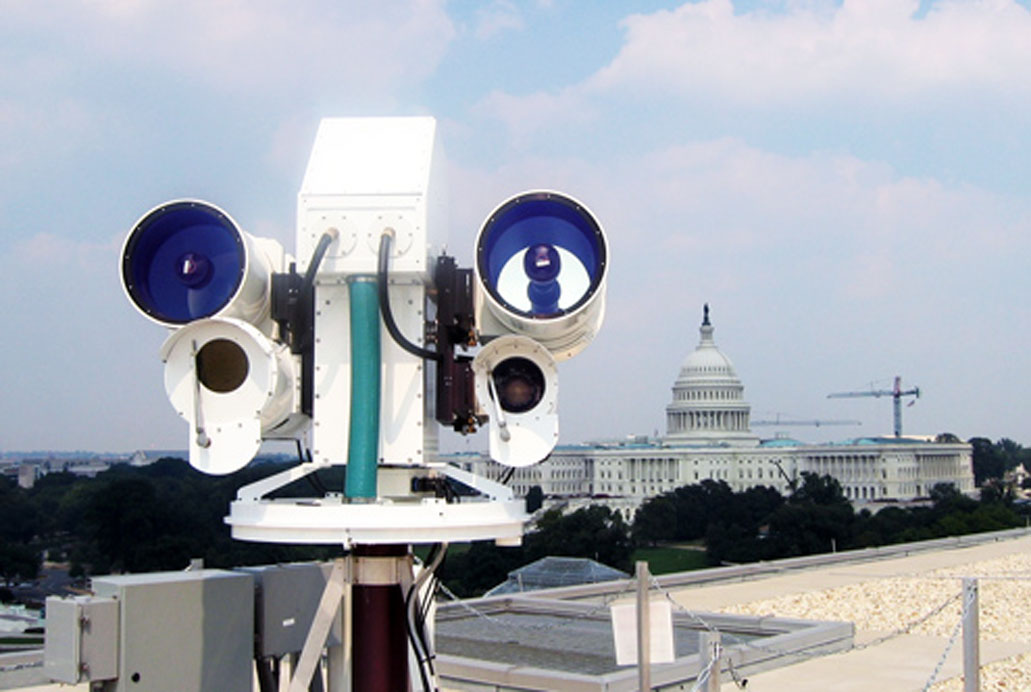The Air Force Life Cycle Management Center’s Battle Management Directorate at Hanscom Air Force Base in Massachusetts issued a request for information regarding a refresh of laser projector components for the Enhanced Regional Situational Awareness (ERSA) system on November 9, 2020. This “system provides the National Capital Region-Integrated Air Defense System (NCR-IADS) with ‘eyes on’ video of aircraft in the NCR through a network of visual and infrared cameras,” according to the contracting notice. The far less talked about laser components work to grab the attention of wayward aviators and warn them away from highly sensitive areas.
The Air Force states that the current ERSA system was introduced in 2004 and underwent a “partial technical refresh” in 2012, although the original lasers have remained in use since the beginning.
The contracting document provides a general description of how the component ERSA system works:
“The ERSA system is a collective suite of lasers, electro-optical (EO) and infrared (IR) sensors, connecting networks, data correlation, applications, decision support tools, and operator displays. The specific mission of the lasers is to generate a visual warning signal visible to the aircrew of aircraft that may have entered into controlled airspace in error.”
“The laser system and the red/green pulses of light it develops are mentioned to all aircraft in their approved flight plan if they are to be near the NCR; additionally, the laser system is published in FAA Notices to Airmen (NOTAMS) for all aircraft.”

The service also identifies the current limitations that it hopes to address with regard to the eight laser systems deployed throughout the NCR. Each of these lasers is collocated and bore-sighted to a camera system. If an aircraft needs to be warned, the laser projects a beam of light that is focused and compressed using a telescope. The Air Force notes that the telescope units and fiber-optic links are still supportable and it’s only the laser units that need to be swapped out for newer equipment.
The RFI notice states that the government is looking for existing technical solutions that could be adopted, or modified if needed, for integration within the existing NCR-IADS architecture. “The NCR-IADS ERSA system seeks non-proprietary, open system refresh that meets or exceeds current capabilities and provides a more efficient, effective, and supportable laser projection/warning system,” the RFI reads before adding that the government requires a technical solution that can be implemented “rapidly.”

The document doesn’t provide any meaningful data on the performance or capabilities of the lasers used in the existing NCR-IADS ERSA architecture but does say that the replacement laser system is required to be accommodated in an enclosure measuring approximately 16 x 10 x 5 inches and 8 x 5 x 13 inches.
Clearly, a highly focused laser beam would be able to get the attention of a pilot who may have unwittingly strayed into the National Capital Region. ERSA is not designed to deliberately disorient or confuse a pilot with hostile intent, but it’s worth noting that potentially hazardous lasers are used around airports and other locales to blind and disorient aircrew. These tactics are not only used by individual actors, but they have also been adopted by peer-states, as well.

ERSA is just one component of the larger NCR-IADS network, which originated as an urgent capability initiated by North American Aerospace Defense Command, or NORAD, after the terrorist acts of September 11, 2001. While provisions have always been made for the general air defense of America’s capital, NCR-IADS has become increasingly optimized to detect and track low-altitude, low-speed airborne threats.
The War Zone has, in the past, examined what can happen when a possible intruder enters the airspace surrounding Washington D.C. and specifically how these cameras can work to rapidly attempt to identify the aircraft in question. You can read that piece here. The bottom line is that seconds can make the difference between engaging a target with deadly force and waiting for it to be escorted away, so the visual ID capabilities that these telephoto, stabilized cameras provide is absolutely critical.
Today, the NCR-IADS also includes U.S. Coast Guard MH-65 Dolphin helicopters to intercept “slow-movers,” Avenger short-range air defense systems, and medium-range NASAMS surface-to-air missiles, as well as supersonic F-16 Viper fighters on round-the-clock alert duty at Andrews Air Force Base. You can read more about each of these “hard-kill” elements here. There are also electronic warfare systems now deployed to deal with the drone threat, as well.

The NCR-IADS has been frequently updated, reflecting the critical role it plays in defending the Capital Area. Now, the latest enhancements for the ERSA should ensure that its laser projection capability keeps pace with evolving technologies.
Contact the author: thomas@thedrive.com
